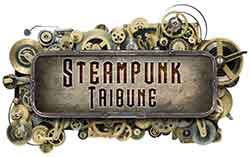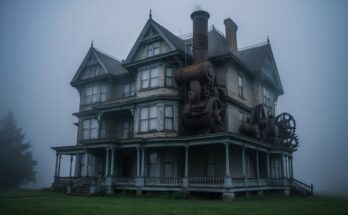Steampunk literature is a subgenre of science fiction or speculative fiction that typically features steam-powered machinery and Victorian-era settings. The term “steampunk” was coined in the 1980s as a blend of “steam” (referring to steam-powered machinery) and “punk” (referring to the countercultural movement), and it has since evolved to encompass a wide range of media, including literature, film, television, and video games.
Classic Steampunk books
Classic works of steampunk literature include:
The Time Machine
The Time Machine” is a science fiction novella by H.G. Wells, first published in 1895. The story follows a scientist known only as “The Time Traveler” who creates a machine that allows him to travel through time. He travels to the year 802,701, where he finds a society of humanoid creatures who live in a seemingly utopian world. However, upon further investigation, the Time Traveler discovers that this society is divided into two distinct classes: the Eloi, who live a leisurely life of ease and comfort, and the Morlocks, who are subterranean creatures who keep the machinery of the society running. As the Time Traveler tries to understand the relationship between these two groups, he becomes trapped in the distant future and must find a way to escape. .
Twenty Thousand Leagues Under the Sea
Twenty Thousand Leagues Under the Sea” is a science fiction novel by Jules Verne, first published in 1870. The story follows the adventures of the eccentric Captain Nemo and his submarine, the Nautilus, as they travel the depths of the ocean. Along the way, they encounter giant squids, coral reefs, and sunken ships, and Captain Nemo reveals to the narrator, Professor Aronnax, the secrets of his past and his motivations for living beneath the waves.
As they journey on, the group also encounters various threats, including clashes with other ships and sabotage from within the Nautilus. Eventually, they come across an underwater city and a lost civilization, leading to even more danger and discovery.
The Steam House (1880)
Jules Verne’s 1880 novel, The Steam House (La maison à vapeur), tells the story of a group of British colonists in India and their voyage via a steam-powered mechanical elephant. Along their journey, the reader is treated to vivid descriptions concentrated on the scenery, as well as historical information and reflections.
Set after the Indian Rebellion of 1857 against Britain, this book (also known as “The End of Nana Sahib”) tells the story of rebel leader Nana Sahib, who vanished after the rebellion was crushed. Verne gives a fictional explanation for his disappearance.
A Connecticut Yankee in King Arthur’s Court
A Connecticut Yankee in King Arthur’s Court” is a novel by Mark Twain, first published in 1889. The story follows the adventures of a practical and resourceful man named Hank Morgan, who is transported back in time to the days of King Arthur and the knights of the Round Table.
Upon arriving in this medieval world, Hank uses his knowledge of modern technology and culture to gain power and influence, eventually becoming a trusted advisor to the king. However, his efforts to modernize and improve the society are met with resistance, and Hank finds himself fighting against the superstitions and prejudices of the time.
Throughout the novel, Twain uses Hank’s experiences to comment on the progress of society and the dangers of blindly following tradition.
These works, which were published during the Victorian era, feature steam-powered machinery and alternate histories or futures that often explore the consequences of technological advancements.
Modern Steampunk books
In more modern adaptations, steampunk literature has often been used as a means of retelling or reinterpreting classic works of literature or history. For example:
The League of Extraordinary Gentlemen
The League of Extraordinary Gentlemen” is a graphic novel series by Alan Moore and Kevin O’Neill, first published in 1999. The series is set in an alternate history where characters from classic literature and folklore exist and are recruited to form a secret society to defend the British Empire.
The team is comprised of legendary characters such as Captain Nemo, Dr. Jekyll, and Allan Quatermain, and they are tasked with stopping various threats to the empire, including an invasion by Martians and a plot by Professor Moriarty. The series combines elements of steampunk, adventure, and superhero genres, and it is known for its intricate and clever use of literary references. “The League of Extraordinary Gentlemen” has been adapted into a film and a television show, and it has inspired numerous spin-off works.
The Anubis Gates
The Anubis Gates” is a fantasy novel by Tim Powers, first published in 1983. The story is set in an alternate version of the 19th century where time travel and magic are real, and it follows the adventures of a group of travelers who are hired by a wealthy collector to attend a series of magic shows in Egypt.
As the travelers explore the ancient land and attend the shows, they become caught up in a plot involving the ancient Egyptian god Anubis and a mysterious time traveler who is trying to manipulate the past. The novel combines elements of historical fiction, horror, and science fiction, and it is known for its intricate plot and richly detailed world-building. “The Anubis Gates” has won numerous awards and has been recognized as a classic of fantasy literature.
Other modern examples of steampunk literature include
“The Gormenghast Novels” by Mervyn Peake, “The Iron Duke” by Meljean Brook, and “Perdido Street Station” by China Miéville. These works often incorporate elements of fantasy or horror, and they often explore themes of rebellion and social change.
Steam punk films, televisions shows and video games
Steampunk literature has also inspired numerous films, television shows, and video games, including:
The Wild Wild West
The Wild Wild West” is an American television series that aired from 1965 to 1969. The show is set in the late 19th century and follows the adventures of two Secret Service agents, James West and Artemus Gordon, who are tasked with protecting President Ulysses S. Grant and solving crimes and conspiracies.
West and Gordon use their skills and gadgets to take on a variety of villains, including mad scientists, thieves, and spies. The show is known for its creative use of steampunk-inspired technology, such as steam-powered vehicles and weapons, and its campy sense of humor. “The Wild Wild West” was popular during its original run and has been recognized as a classic of television history.
Checkout The Wild Wild West of Steampunk: A Complete Guide
Sherlock Holmes
Sherlock Holmes” is a film directed by Guy Ritchie, released in 2009. The film is a modern retelling of the classic Sherlock Holmes stories by Sir Arthur Conan Doyle, set in Victorian-era London. The film stars Robert Downey Jr. as Sherlock Holmes and Jude Law as Dr. John Watson, and it follows their efforts to stop the villainous Lord Blackwood, who is plotting to take over the city using dark magic.
Throughout the film, Holmes uses his skills of observation and deduction to solve mysteries and outwit his foes, and he is aided by Watson and a host of other characters from the original stories, including Inspector Lestrade and Mrs. Hudson. The film features a blend of action, mystery, and humor, and it is known for its stylish visual effects and interpretation of the classic characters. “Sherlock Holmes” was a commercial and critical success and spawned a sequel, “Sherlock Holmes: A Game of Shadows,” in 2011.
15 Best Steampunk Movies You Must Watch
Bioshock Infinite
Bioshock Infinite” is a first-person shooter video game developed by Irrational Games and released in 2013. The game is set in an alternate reality in the year 1912, where the player assumes the role of Booker DeWitt, a private investigator who is sent to the floating city of Columbia to rescue a woman named Elizabeth.
As Booker navigates the city, he encounters a variety of characters, including the city’s tyrannical leader, Zachary Comstock, and becomes caught up in a conflict between rival factions. The game is known for its complex and thought-provoking story, which explores themes of identity, free will, and the consequences of technology. “Bioshock Infinite” received widespread critical acclaim and numerous awards, and it has been recognized as one of the best video games of all time.
The enduring popularity of steampunk can be attributed to its unique blend of historical and speculative elements, as well as its themes of innovation and exploration.
We have more articles of Steampunk Movies
Conclusion
The conclusion of steampunk literature is that it has come a long way since its inception in the late 19th century. From its roots in Victorian-era science fiction, steampunk has evolved into a genre that encompasses a wide range of stories and characters. Classic works such as Jules Verne’s 20,000 Leagues Under the Sea and H.G. Wells’ The Time Machine have been adapted for modern audiences, while new works such as “The Wild Wild West” and “Bioshock Infinite” have pushed the boundaries of the genre. Steampunk literature continues to be a source of inspiration and entertainment for readers of all ages.




